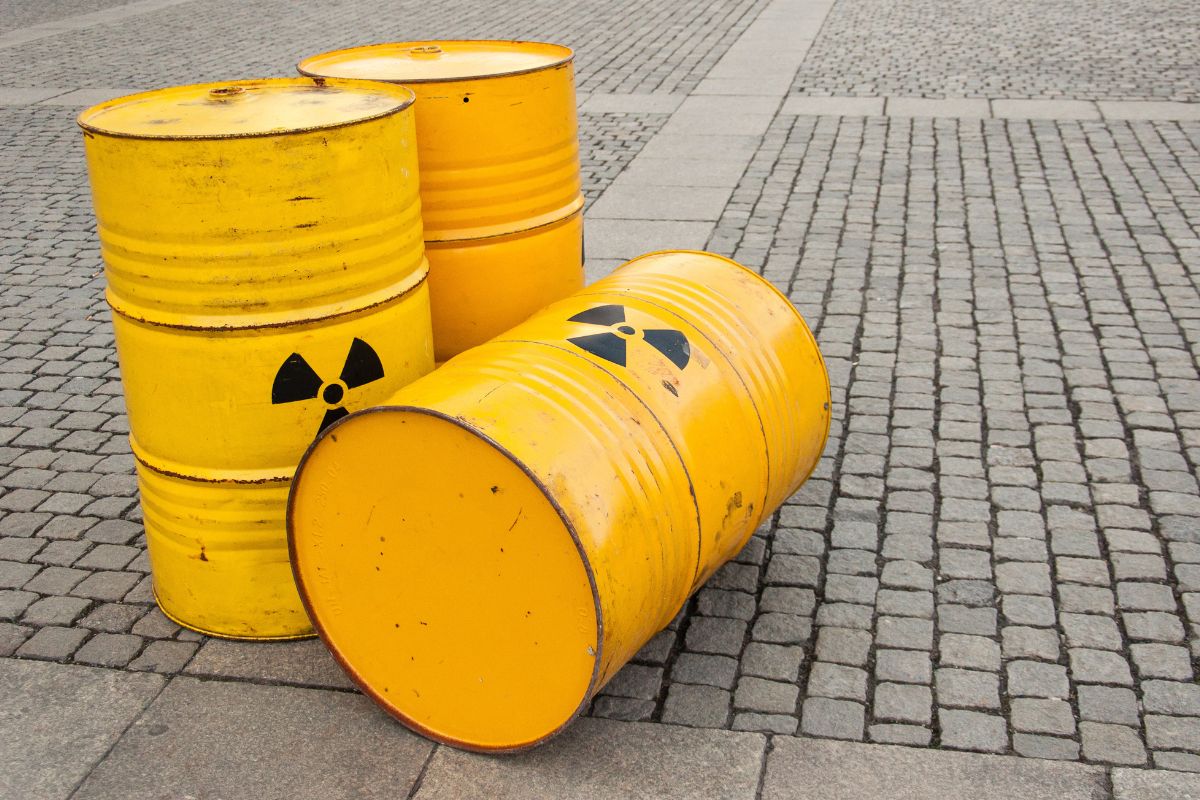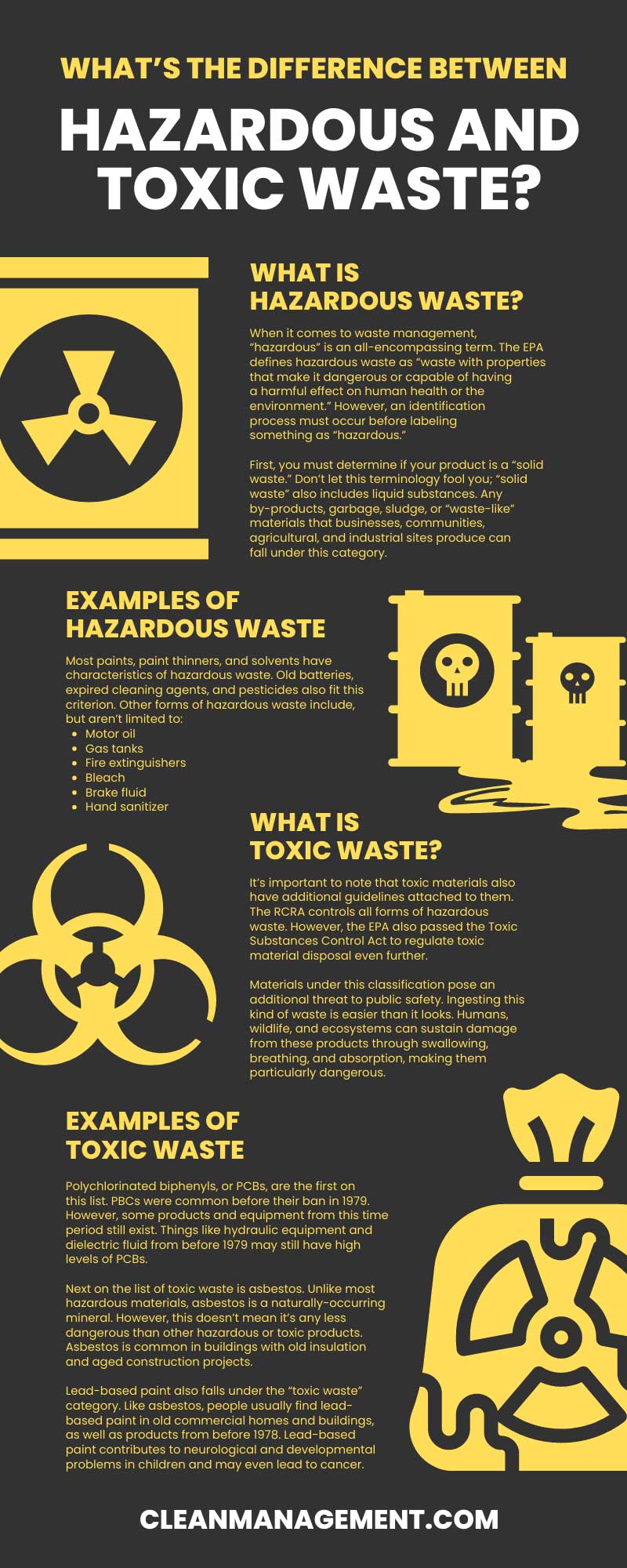What’s the Difference Between Hazardous and Toxic Waste?

People often use the words “hazardous” and “toxic” as synonyms. In most cases, this is correct. However, when talking about industrial waste, the terms are not as interchangeable as they may seem.
The EPA has strict regulations to control how businesses dispose of their by-products. They determine these guidelines by writing specific definitions for different forms of waste. Knowing the difference between hazardous and toxic waste will keep your company from making costly disposal mistakes.
What Is Hazardous Waste?
When it comes to waste management, “hazardous” is an all-encompassing term. The EPA defines hazardous waste as “waste with properties that make it dangerous or capable of having a harmful effect on human health or the environment.” However, an identification process must occur before labeling something as “hazardous.”
First, you must determine if your product is a “solid waste.” Don’t let this terminology fool you; “solid waste” also includes liquid substances. Any by-products, garbage, sludge, or “waste-like” materials that businesses, communities, agricultural, and industrial sites produce can fall under this category.
Next, you’ll need to see if your waste falls into the “listed waste” or “characteristic hazardous waste” categories. Some pieces of EPA legislation exclude certain solid wastes from regulations. Being familiar with these lists can help you determine the best course of action for your garbage.
Listed Waste
Thanks to the Resource and Recovery Conservation Act (RCRA), there are four waste “lists” that substances can fall under. The EPA created these lists to regulate particularly harmful products and keep them from interfering with human and environmental health.
- F-List: Waste from nonspecific sources
- K-List: Source-specific waste
- P-List: Highly toxic products
- U-List: Dangerous yet slightly less-toxic materials
Characteristic Waste
Waste lists feature over 500 different products and materials. However, just because something isn’t on these lists doesn’t mean it’s not hazardous. Materials that contain certain “hazardous” characteristics also fall under RCRA regulations.
Corrosivity
One characteristic that can further define “hazardous waste” is corrosivity. Corrosive materials include things that are strong acids or bases. Anything with a pH level less than 2 or greater than 12.5 falls under this category.
Corrosive materials pose an extreme threat to human safety. These products can destroy human tissue and other durable materials with minimal effort. In the interest of public safety, businesses must handle waste with corrosive properties with extreme care.
Reactivity
Another property to look out for in your non-listed industrial waste is reactivity. Reactive products are highly unstable. They are volatile even under controlled conditions, and can react to various external stimulation.
Reactions look different depending on the waste. Some reactive materials emit toxic gases, while others are explosion hazards. If you generate waste that reacts to water, high heat, or pressure, you should proceed with caution during the labeling, storage, and disposal process.
Ignitability
Does your establishment produce garbage that catches fire easily? If so, this waste falls under the “ignitability” characteristic. Ignitable products are also hazardous because of the extreme damage they can cause to businesses, communities, and ecosystems.
There are various tests professionals can conduct to determine a material’s level of ignitability. Closed-cup methods and solid ignitability tests will tell you whether or not your waste has the potential to catch on fire.
Toxicity
Finally, the last property that can help identify hazardous waste is toxicity. This characteristic includes anything that can cause illness or death after ingestion. It also contains materials that can poison the environment and surrounding wildlife.
“Toxicity” being a subset of hazardous waste is exactly why the two terms aren’t interchangeable. Toxic waste is markedly different than other materials the EPA has deemed “hazardous.”
Examples of Hazardous Waste
We mentioned earlier that waste lists contain over 500 products and materials. This number doesn’t even include things that don’t make it on these classification lists. With so much information at your disposal, it’s helpful to look at examples of hazardous waste to help you identify items in your own business.
Most paints, paint thinners, and solvents have characteristics of hazardous waste. Old batteries, expired cleaning agents, and pesticides also fit this criterion. Other forms of hazardous waste include, but aren’t limited to:
- Motor oil
- Gas tanks
- Fire extinguishers
- Bleach
- Brake fluid
- Hand sanitizer
What Is Toxic Waste?
As you probably noticed, “toxicity” is a characteristic of hazardous waste. However, that doesn’t mean that all hazardous waste is toxic. While this is a common crossover that most businesses encounter, toxic materials don’t encompass all kinds of hazardous waste.
It’s important to note that toxic materials also have additional guidelines attached to them. The RCRA controls all forms of hazardous waste. However, the EPA also passed the Toxic Substances Control Act to regulate toxic material disposal even further.
Materials under this classification pose an additional threat to public safety. Ingesting this kind of waste is easier than it looks. Humans, wildlife, and ecosystems can sustain damage from these products through swallowing, breathing, and absorption, making them particularly dangerous.
Examples of Toxic Waste
Now that you know the differences between hazardous and toxic waste, what are some examples of the latter? The Toxic Substances Control Act focuses on three primary materials that have toxic properties.
Polychlorinated biphenyls, or PCBs, are the first on this list. PBCs were common before their ban in 1979. However, some products and equipment from this time period still exist. Things like hydraulic equipment and dielectric fluid from before 1979 may still have high levels of PCBs.
Next on the list of toxic waste is asbestos. Unlike most hazardous materials, asbestos is a naturally-occurring mineral. However, this doesn’t mean it’s any less dangerous than other hazardous or toxic products. Asbestos is common in buildings with old insulation and aged construction projects.
Lead-based paint also falls under the “toxic waste” category. Like asbestos, people usually find lead-based paint in old commercial homes and buildings, as well as products from before 1978. Lead-based paint contributes to neurological and developmental problems in children and may even lead to cancer.
Why Does it Matter?
Understanding these differences is imperative if you want to maintain a safe working environment. Handling hazardous and toxic materials correctly upholds the well-being of your staff, waste management professionals, community members, and local ecosystems.
Knowing how hazardous and toxic waste differs from each other also saves your business money and boosts your credibility. Mishandling certain materials can lead to enormous fines, suspended business licenses, and a loss of trust within your community.
To avoid these negative consequences, contact Clean Management Environmental Group. From San Antonio waste disposal services to cleanups in Houston, we can cover the entire Lone Star State. We have resources that span across the entire country, so reach out today and let us help you manage your waste.

